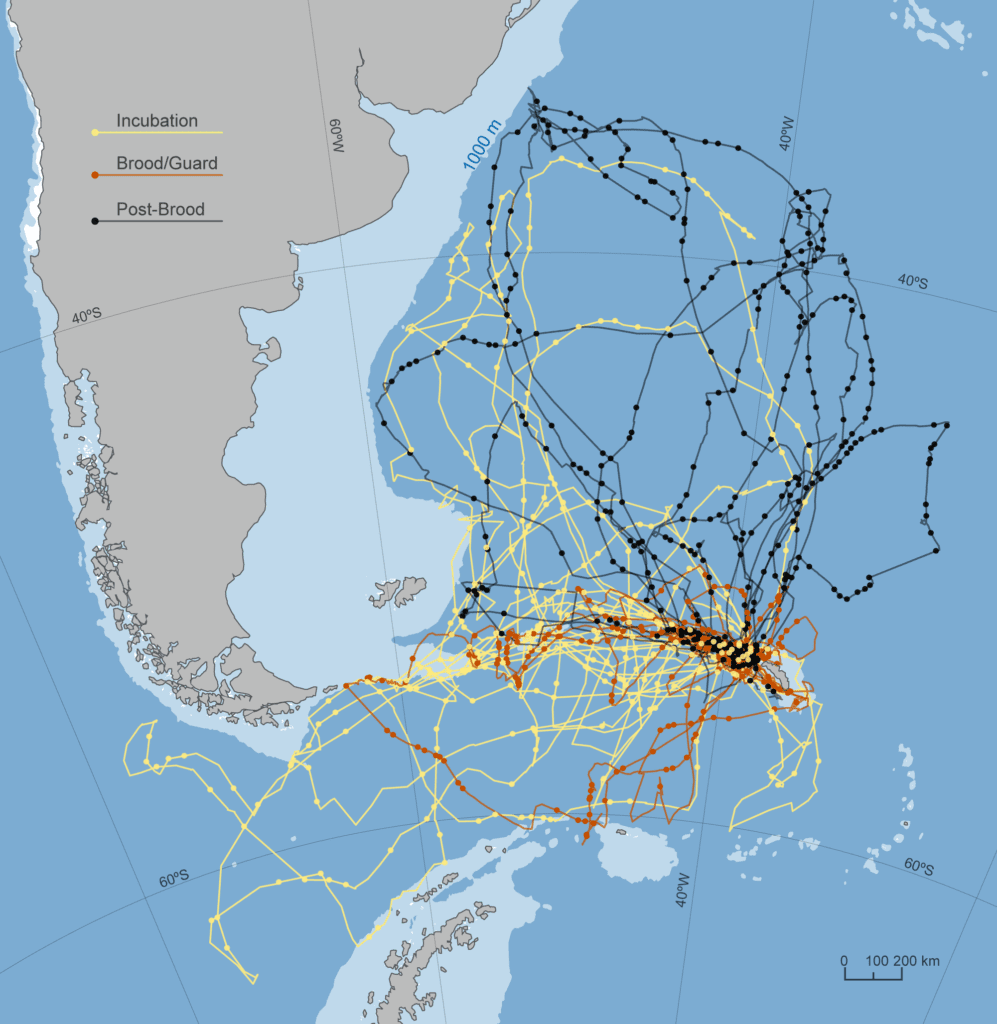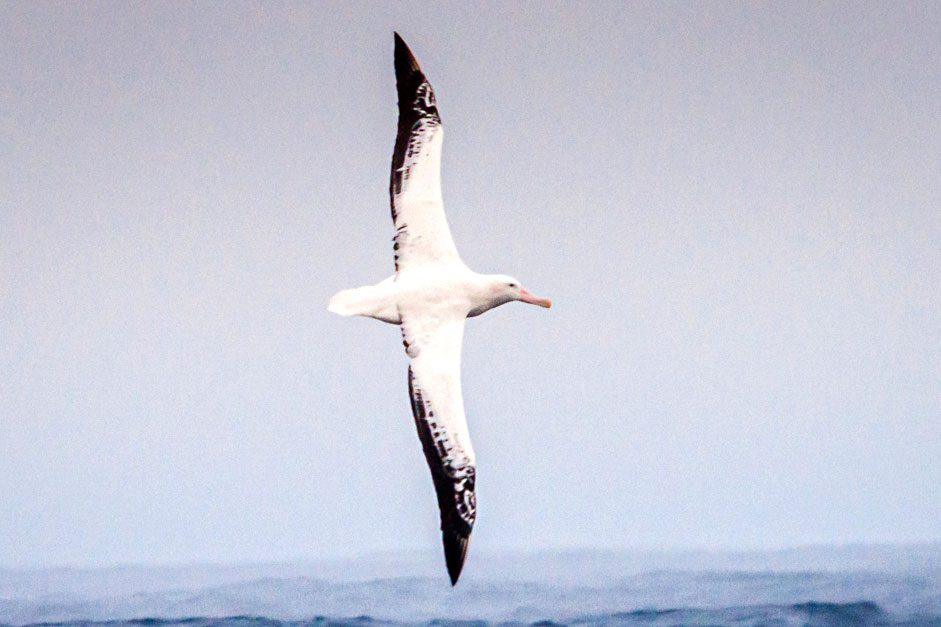Wandering albatrosses are highly adapted to long-distance soaring
flight, assisted by a wingspan of up to 11 feet -the largest known of
any living bird.
Researchers are unlocking new clues about how these iconic birds are such amazing flyers.
Researchers are unlocking new clues about how these iconic birds are such amazing flyers.
By analyzing GPS tracks of wandering albatrosses, researchers have found that the birds’ airspeed increases with wind speed up to a maximum of 20 meters per second (45 miles per hour).
Researchers developed a model of dynamic soaring, which predicts that the birds could fly much faster than 20 meters per second (m/s).
Researchers developed a model of dynamic soaring, which predicts that the birds could fly much faster than 20 meters per second (m/s).
However, researchers hypothesize that the birds limit their maximum across-wind airspeeds to about 20 m/s in higher wind speeds (and greater wind turbulence), probably to keep the aerodynamic force on their wings during dynamic soaring well below the mechanically-tolerable limits of wing strength.
The paper concludes that the birds limit airspeed by adjusting the turns in their trajectories to be around 60° and that in low winds the birds exploit updrafts over waves to supplement dynamic soaring.
Although a theoretical model predicted that the minimum wind speed necessary to support dynamic soaring is greater than 3 meters per second (m/s), GPS-tracked albatrosses were observed in flight at wind speeds as low as 2 m/s.
The paper concludes that the birds limit airspeed by adjusting the turns in their trajectories to be around 60° and that in low winds the birds exploit updrafts over waves to supplement dynamic soaring.
Although a theoretical model predicted that the minimum wind speed necessary to support dynamic soaring is greater than 3 meters per second (m/s), GPS-tracked albatrosses were observed in flight at wind speeds as low as 2 m/s.
Researchers hypothesize at these very low wind speeds, wandering albatrosses fly by obtaining additional energy from updrafts over water waves.
The study points to ways in which theoretical models need to be refined to capture more faithfully the amazing complexity and beauty of albatross flight.
(Photo credit: Philip Richardson, ©Woods Hole Oceanographic Institution)
The study points to ways in which theoretical models need to be refined to capture more faithfully the amazing complexity and beauty of albatross flight.
(Photo credit: Philip Richardson, ©Woods Hole Oceanographic Institution)
Wandering albatrosses, which are an iconic sight in the Southern Ocean, are highly adapted to long-distance soaring flight.
Their wingspan of up to 11 feet is the largest known of any living bird, and yet wandering albatrosses fly while hardly flapping their wings.
Instead, they depend on dynamic soaring—which exploits wind shear near the ocean surface to gain energy—in addition to updrafts and turbulence.
Now researchers, including Philip Richardson, a senior scientist emeritus in Physical Oceanography Department at the Woods Hole Oceanographic Institution (WHOI), are unlocking more clues about exactly how wandering albatrosses are such amazing flyers.
In a new paper analyzing GPS tracks of wandering albatrosses, researchers have found that the birds’ airspeed increases with wind speed up to a maximum airspeed of 20 meters per second (m/s; 45 mph).
Researchers developed a model of dynamic soaring, which predicts that the birds could fly much faster than 20 m/s.
The paper concludes that the birds limit their airspeed by adjusting the turns in their trajectories to be around 60°, and that in low winds the birds exploit updrafts over waves to supplement dynamic soaring.
“We hypothesize that wandering albatrosses limit their maximum across-wind airspeeds to ~ 20 m/s in higher wind speeds (and greater wind turbulence), probably to keep the aerodynamic force on their wings during dynamic soaring well below the mechanically-tolerable limits of wing strength,” according to the paper, “Observations and Models of Across-wind Flight Speed of the Wandering Albatross,” published in the journal Royal Society Open Science.
The paper adds that, given the complex field of wind waves and swell waves often present in the Southern Ocean, “it is also possible that birds find it increasingly difficult to coordinate dynamic soaring maneuvers at faster speeds.”
Regarding low flight speeds by albatrosses, the paper notes that a theoretical model predicted that the minimum wind speed necessary to support dynamic soaring is greater than 3 m/s.
“Despite this, tracked albatrosses were observed in flight at wind speeds as low as 2 m/s.
We hypothesize at these very low wind speeds, wandering albatrosses fly by obtaining additional energy from updrafts over water waves,” according to the paper.
“We tried to figure out how these birds are using the winds to go long distances—without overstressing their wings—for foraging for food and returning to feed their chicks.
To do that, we modeled dynamic soaring and what different turn angles would do to stress on the birds’ wings and speed over the water,” said journal paper co-author Richardson.
A dynamic soaring trajectory is an s-shaped maneuver consisting of a series of connected turns, he noted.
“This research is a step in the direction of understanding how wandering albatrosses are able to do these foraging trips and maintain a fairly large population.
These birds figured out an amazing way to use the wind to almost effortlessly soar for thousands of miles over the ocean.
We wanted to find out exactly how they did it,” he said.
In addition to learning more about albatrosses, the study could have broader implications for helping researchers better understand how to use dynamic soaring to power potential albatross-type gliders to observe ocean conditions, Richardson added.

Trajectories of breeding wandering albatrosses nesting on South Georgia Island in the South Atlantic.
These birds are highly adapted to long-distance soaring flight assisted by a wingspan of up to 11 feet--the largest known of any living bird.
They use the winds to soar thousands of miles seeking food to bring back to nourish their chicks.
(Map by Natalie Renier, ©Woods Hole Oceanographic Institution)
These birds are highly adapted to long-distance soaring flight assisted by a wingspan of up to 11 feet--the largest known of any living bird.
They use the winds to soar thousands of miles seeking food to bring back to nourish their chicks.
(Map by Natalie Renier, ©Woods Hole Oceanographic Institution)
For the study, researchers used GPS to track 46 wandering albatrosses during foraging trips the birds made between February to September 2004.
The birds were breeding on Bird Island, which is off the northwest tip of South Georgia in the Southern Atlantic Ocean.
Wandering albatrosses lack sufficient musculature to sustain continuous flapping flight for long periods of time; however they have a shoulder lock that mechanically holds their wings outstretched so that little energy is expended while soaring, according to the paper.
Since the earliest days of scientific inquiry, the way that many birds are able soar—that is, fly without flapping their wings—has fascinated and perplexed observers, said paper co-author Ewan D. Wakefield, affiliate researcher at the University of Glasgow and postdoctoral research associate at the University of Durham, UK.
Wandering albatrosses are particularly remarkable for their ability to soar over the surface of the sea for long periods, covering vast distances, Wakefield said.
He added that the physical principles explaining dynamic soaring flight were established over a century ago: Basically, albatrosses swoop up and down between layers of fast and slow moving air near the surface of the sea, gaining airspeed each time they do so.
“However, as our study shows, real-world albatross flight differs considerably from the predictions of simple physical models,” Wakefield said.
“On the one hand, our GPS-tracking data show that they can and do fly in lighter winds than dynamic soaring models say should be possible.
We suspect that this is because they can also fly by surfing updrafts created by the large waves that constantly surge around their Southern Ocean home.
On the other hand, the upper limit of albatrosses' airspeed that we measured is much slower than physics predicts.
We think that this is because albatrosses need to keep the forces on their wings within tolerable limits.
After all, they're made from bone and muscle, not aluminum and titanium.
Our study therefore points to ways in which theoretical models need to be refined to capture more faithfully the amazing complexity and beauty of albatross flight.”
Richardson recalled being entranced by wandering albatrosses ever since he observed them during a 1997 oceanographic cruise in the South Atlantic Ocean.
“We were steaming upwind at 15 knots, pounding into waves, and these albatrosses caught up to us from astern and were cruising around and having a grand old time,” Richardson said.
“I sat there for hours watching these birds in amazement, and wondering how they could fly like that.
Now we are learning more about how they do it.”
Funding for this research was provided by the Woods Hole Oceanographic Institution emeritus fund and the UK Natural Environment Research Council.

No comments:
Post a Comment